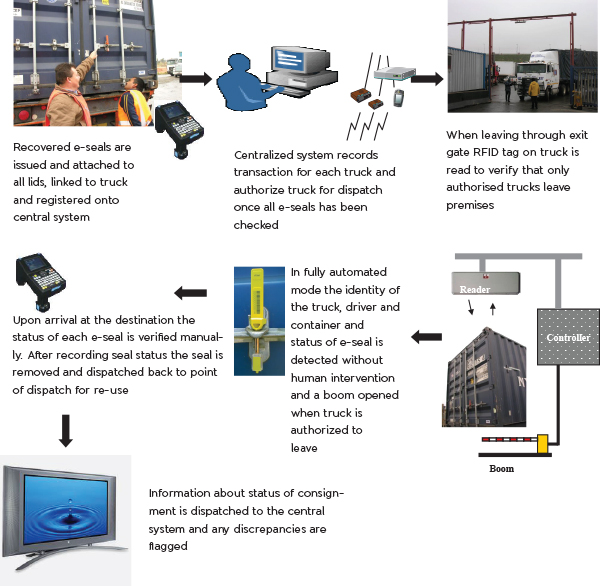Electronic Cargo Tracking
Recent developments in the realm of international trade have increased the need for heightened security to prevent multi-frontal attacks. The dual missions of protecting national security and collecting duties and taxes drive governments’ interest in maintaining the integrity of the supply chain. The interest of private companies in just-in-time, reliable delivery, cost-effective logistics, and maintaining the integrity of goods leads to the development of many tracking systems.

Lost or resting cargo containers and vehicles represent the point in the supply chain at which goods and conveyances are most vulnerable. Some studies have indicated that 70 percent of senior executives are not satisfied with their ability to track their moving assets to ensure integrity and safety. Tracking cargo and vehicles allows for advanced processing of information by border and intelligence agencies and assists in defeating the vulnerabilities associated with inland dray age, the most vulnerable aspect of the supply chain. To adequately provide security, the cargo and vehicle must be able to be tracked independently, but the tracking mechanism needs the capability to associate the two data points.
Soltic Africa is a leader in developing, deploying and supporting novel technologies for tracking assets, fleet, and various types of resources, had developed most innovative way of tracking cargo and shipment using integrated technologies like GPS, GPRS, RFID and Sensors. Soltic Africa utilizes complete advantage provided by our Framework for application development and support of Cargo and Shipment Tracking System, which in-turn help the organizations to utilize their current eco system without much change, in-order to provide better Return On Investment (ROI) in shorter period of time.
We provide an integrated solution that consists of components as below:
- RFID
- GPS & GPRS
RFID Technology in Cargo and Shipment Tracking
Radio frequency identification devices (RFID) are low-cost tags that assist in the tracking of goods and vehicles. These devices are placed on individual items and can either be active, i.e., constantly emitting a radio frequency signal; or passive, i.e., only emitting a signal when queried by an outside source.
In order to track goods, readers (either hand-held or fixed) need to be installed to track and record the numbers from the RFID devices affixed to each product or container. Installation of these readers, however, adds additional costs which would be assumed by the shipper or passed along to the consumer/end user.
RFID tags are limited in the number that can be screened by each reader at one time. For large numbers of loose goods, individually tagging each good is not an efficient use of resources. Tagging the unit containing these loose goods is a more practical solution. RFID tags may not be practical for all applications, including tracking liquids and items wrapped in metal or foil, as these environments can create interference.
The RFID tags only serve as a tracking Cargo and vehicle tracking is the ability to trace goods, their containers, and their conveyances from the point of origin to their destination. Tracking is increasingly associated with information transfer using smarter tools such as radio frequency identification devices and global positioning systems.
The RFID tags only serve as a tracking mechanism; they do not possess any effective security applications. To work properly, specific frequencies will need to be designated for RFID use only. Government assistance and cooperation is needed in order to prevent interference with other existing devices and applications.